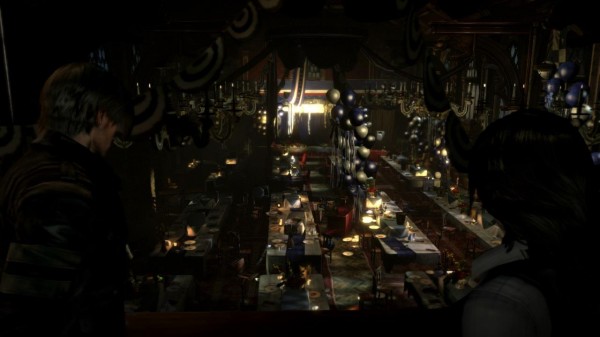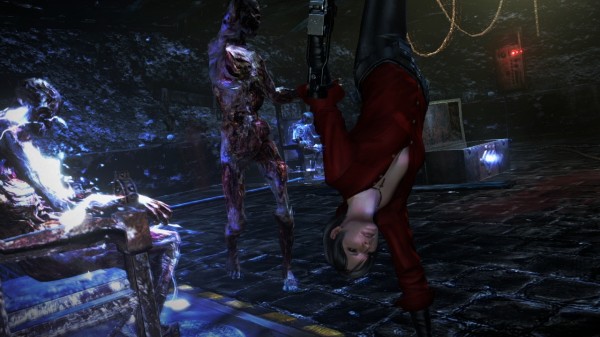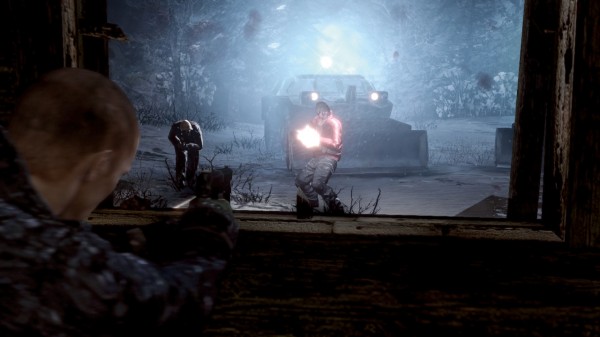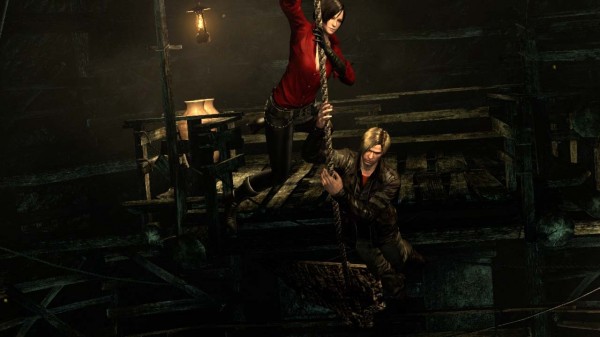
Resident Evil 6 Xbox 360 Review
The last of the Resident Evil games to hit in 2012 is finally upon us, and no doubt this new entry in the main line of games is going to cause quite a stir with diehard fans of the franchise as they wonder what the hell Capcom is doing with their beloved, once-almighty horror series. Resident Evil is no longer the scary, continuous suspense game that it used to be. It has evolved into something more in line with an action game containing a horror-themed plot. There is no doubt Capcom has brought us the biggest, loudest and most content-rich Resident Evil to date, with 600 staff supposedly to have worked on the title, but does this whole package come together to make for a fantastic game?
Capcom has delivered a story that continues on with the typical Resident Evil nonsense – probably more so than ever before – but it does entertain in both good and bad ways. The plot is set over a period of six months as it leads up to a global scale infection beginning in China. Resident Evil 6 features series veterans like Leon S. Kennedy and Chris Redfield, and newcomer Jake Muller – the son of the awesome, but melted, Albert Wesker. Being able to see the heroes return in this instalment is good fan service, but it is a shame that some of the lesser favourites haven’t made it in like Barry Burton, as this could have been a big Resident Evil party of all the best characters coming together for a Jill sandwich and a catch-up.

If there is one thing that I can applaud Capcom for it is that they have jammed packed the disc with plenty of content. The bulk of the game is the four campaigns. From the beginning you are given the option to play either Leon’s, Chris’ or Jake’s campaign, with Ada’s unlocking after you have finished those three. Each campaign has its own levels and plot that cross over with the others, completing the overall story. The gameplay is slightly different in each campaign, with each one coming with its own identity and user interface, as if Capcom wanted to cover multiple games but decided to bring those ideas together and make it into one collection with no true solid direction.
Leon’s campaign is most likely the story that will appeal to fans as his campaign focuses on zombies and tries to implement the thrilling aspect and pacing of Resident Evil 4. For example, the zombie shadows projecting onto the tunnel walls grow in size until said zombies physically appear around the corner and notice Leon in their sights, turning their groaning sounds into ravaging noises of the undead that rush towards Leon to have a chomp of his 90s Terminator 2, John Connor hairstyle. It is atmospheric scenes like this that tingle some of the Resident Evil of old. Level design is extremely linear, not just in this campaign, but in all of them, and it disappointingly never opens up. Resident Evil 4 gave a sense of exploration with its open areas and multiple routes. This is all gone in Resident Evil 6, instead following the formula of linear first-person shooter games that force you down one-way corridors – only this time that corridor is full of destruction that blocks everything but the right way to go. It’s the curse of the modern video game that I wish developers would stop exhausting.

Chris Redfield’s campaign is where the adrenaline-filled action pours into the game. Gone are the zombies and the atmospheric pacing. It is now replaced with J’avos, strange humans who have infected themselves with the newly produced C-virus and can mutate additional limbs or wings. Imagine humans crossed with insects but carrying guns – disturbing, but these are some genuinely good enemy designs. The problem with introducing gun-carrying enemies means Chris is forced to use the cover system to stay alive, a mechanic that does not feel as snappy to work with as most other third-person shooters, and something that Leon’s campaign never requires you to do as gun-wielding zombies are uncommon for him to encounter. Chris’ campaign does not seem to dish out enough ammunition, making every head shot count to gain more bullets. Every character comes with hand-to-hand combat moves to fend off the new monstrosities. The melee system in play is powerful, killing J’avos with a one, two, three hit combo and then a stamp on their face.
Jake’s campaign continues the action but is often given downtime between each firefight. Jake also has to deal with the Ustanak, a towering pile of muscle that acts very similar to the Nemesis from Resident Evil 3. You will encounter him multiple times throughout, and he is mostly annoying because the Ustanak cannot be damaged and often kill Jake in one or two hits. The Ustanak can be the cause of frustration when this hulk of invincibility charges at you in parts of the game that require you to look for a way past him. There is nothing you can do but take the hit and die after he spots you – awful sections that spoil an otherwise okay, if a bit dull, campaign.

I won’t speak much about Ada’s campaign, other than it is good and flows differently from the others by throwing in puzzles and adding a slower pace to the action. Chapter 2 in Ada’s story gave me huge vibes of the castle section from Resident Evil 4, so that is one good thing. No matter who you pick to play, each campaign is meaty, lasting between 6-8 hours. That’s over 24 hours of gameplay for an action title, which is something unheard of in this modern age of gaming. The deal breaker is that not all 24 hours are enjoyable. You are going to run into areas you will find annoying and go on for too long – it is often the game’s unforgettable bosses that drag on and on and on, for like four or five iterations until they finally die. It just becomes irritating to the point where the fun is lost and it becomes a chore, like all those potential endings in the final The Lord of the Rings film.
Constant smooth gameplay is a bit of problem for Resident Evil 6 due to the inclusion of quick-time events (QTEs). Some of you may know I am a fan of QTEs, but they have to be done right and feel they are representing something meaningful, not 360 degree stick spins that charge up a bar representing Jake changing a boat in one direction. That could have easily been left to the player to control the boat. These strange and wrongly implemented inclusions disrupt the pacing of each campaign and in turn throw the player out of the immersion in what should be some incredible set-pieces, especially with the brilliant-looking graphics and cutscenes that show the Xbox 360 still has some strength left in its seven-year-old legs. Poor vehicle sections don’t make things better either, with the jeep and harrier feeling like generic gun turret sequences with limited movability.

No matter whom you play as, you will have to deal with the extremely close-up, third-person camera. The character model takes up about a third of the screen, and when you do something that requires vigorous movement of the hero, say melee attacks, you cannot grasp what is going on as the camera is covered by the animation. It takes some getting used to before settling down with it, and generally the button prompt causes the attack to lock onto the enemy, so I feel it can be a forgiven handicap for the player.
Aiming over the shoulder is done by holding down LT and helps with precision aiming of head shots – rolling, dodging and aiming on the floor are commands that can only be done when you bring up the gun with LT. The laser sight that appears after a shot seems to move around inside the reticule. A very bizarre inclusion, which I feel is included because of the skill system that is in place. Killing bio organic weapons or smashing boxes will sometimes reward players with skill points, which can be used at the end of a chapter to purchase skills that might give more defence, attack or even more item drops. Most can be upgraded too. While the skill points system is a neat feature, for me personally, I hardly found any of them worthwhile to use, so I kept the same three equipped for most of the game.

Those famous herbs make a return but are used differently than traditionally implemented in a Resident Evil game. You still combine red herbs with green herbs, but now instead of making stronger doses it makes more tablets to put in the dispenser. Think of the dispenser as a pocket-sized box of mints. That’s what it looks like when you press RB to use one to replenish a cube of life. Tablets can be added with a simple key combination that will make the best combination of herbs and automatically add them to the dispenser, so there is no need to go into the item list and create them. There is hardly a moment where you need to mess with inventory space as you can carry plenty of ammo and items.
I decided to play the entire game single player to see how the constant AI partners performed. I only encountered one problem and that was when Leon’s partner got stuck behind a corner piece of a door and required me to go back and detach her from it. The AI is typically great at keeping with you and firing at monsters. The fact that your partner has infinite health helps to make a better gameplay experience than the ever-dying Sheva from Resident Evil 5, and the fact you can ignore them for the most part makes it sufficient enough to enjoy the single player without a buddy. There are parts in Jake’s campaign that require you to wait for the AI to do something, throwing in a stupid camera angle that limits what you can see as it focuses on the direction of Sherry doing her thing. Apart from that, do not expect any terrifying experiences with the AI. Cooperative works well, both online and split-screen.

With so much content already on the disc, the addition of The Mercenaries and Agent Hunt modes throw more options to waste the time away. Agent Hunt allows you to jump into another player’s game as a monster and try to kill them. Think of it as Resident Evil 6’s take on the counter-operative mode in Perfect Dark. I honestly did not spend much time in it, as it was not a mode I was particular fond of. The Mercenaries, however, remains as addictive as ever and will supply that itch for fans that love it.
It comes to the conclusion, then; Resident Evil 6 is nothing like any other Resident Evil game before it. While I feel people might slam it for not being a true Resident Evil game, I did enjoy most of what I played and found it to be a decent time. I prefer it over Resident Evil 5’s lacklustre attempt at copying Resident Evil 4. At least the sixth instalment’s developers had the balls to not simply imitate the GameCube masterpiece.

In the end, you are getting a bloated game with a ridiculous amount of content that is spoiled by some unwanted QTE implementation and vehicle sections, and long boss fights. If you can look past those negatives, then the core gameplay is engaging and rewarding enough to be worthwhile. Resident Evil 6 should have been an amazing game, and it very well could have been if the excess and unwanted fat was trimmed away. Sadly, it’s a bit of a chubby git that has left his old brilliance behind as he tries to adapt to the modern age and play catch-up with the truly thrilling masters of the action genre. Is it disappointing? Yes, but it manages to still be a good bit of fun.
